
Monasterboice are the remains of an early Christian monastic settlement in County Louth in Ireland, north of Drogheda. The ruins are a National monument of Ireland and also give their name to the local village.

Clondalkin is a suburban town situated 10 km south-west of Dublin city centre, Ireland, under the administrative jurisdiction of South Dublin. It features an 8th century round tower that acts as a focal point for the area. Clondalkin forms part of the Dublin Mid-West Dáil constituency.
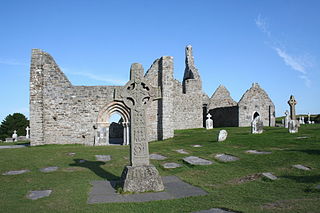
Clonmacnoise is a ruined monastery situated in County Offaly in Ireland on the River Shannon south of Athlone, founded in 544 by Saint Ciarán, a young man from Rathcroghan, County Roscommon. Until the 9th century it had close associations with the kings of Connacht. Saint Ciarán chose to found the monastery in the ancient territory of Ui Maine at a point where the major East-West land route meets the River Shannon after crossing the bogs of Central Ireland known as the Esker Riada. The strategic location of the monastery helped it become a major centre of religion, learning, craftsmanship, and trade by the 9th century; and together with Clonard it was one of the most famous places in Ireland, visited by scholars from all over Europe. From the ninth until the eleventh century it was allied with the kings of Meath. Many of the high kings of Tara (ardrí) and of Connacht were buried here.
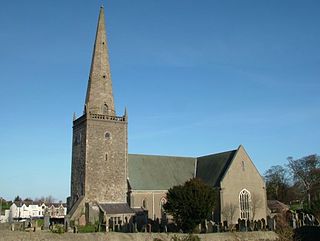
Bangor Abbey was established by Saint Comgall in 558 in Bangor, County Down, Northern Ireland and was famous for its learning and austere rule. It is not to be confused with the slightly older abbey in Wales on the site of Bangor Cathedral.

The Abbey of Kells is a former monastery in Kells, County Meath, Ireland, 64 kilometres (40 mi) north of Dublin. It was founded in the early 9th century, and the Book of Kells was kept there during the later medieval and early modern periods before finally leaving the abbey in the 1650s. Much of the Book of Kells may have been created there, but historians cannot be certain of the exact date and circumstances of its creation.

Termonfeckin or Termonfechin is a small village and townland in County Louth, Ireland. It is within the parish of the same name, and lies 8 km (5.0 mi) north-east of Drogheda. The population of the village was 653 as of the 2006 census, rising to 1,443 in 2011, and to 1,579 by the time of the 2016 census.
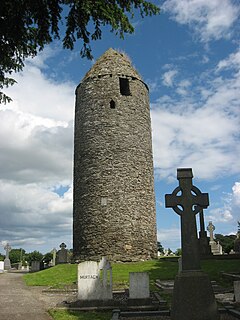
Dromiskin is a village and townland in County Louth, Ireland. It is situated 10 km south of Dundalk, about 1 km inland from the Irish coast.

Armoy is a village and civil parish in County Antrim, Northern Ireland. It is 5.5 miles (9 km) southwest of Ballycastle and 8 miles (13 km) northeast of Ballymoney. According to an estimate in 2013 by the Northern Ireland Statistics and Research Agency it had a population of 1,122.

Inishmurray is an uninhabited island situated 7 km (4 mi) off the coast of County Sligo, Ireland.
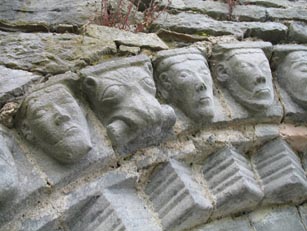
Dysert O'Dea Church near Corofin in County Clare, Ireland stands on the site of an early Christian monastery which was reportedly founded by St. Tola in the 8th century. Most of the present structures are from the 12th century.

Clareen is a village in the parish of Seir Kieran in County Offaly, Ireland. It is located 8 km east of Birr on the R421 regional road.

Clondalkin Round Tower is an Irish round tower or cloigtheach founded by Saint Mochua, also known as Saint Cronan, and located in Clondalkin, South Dublin, Ireland. It is now a National Monument of Ireland. It's also become a museum that houses a cafe.

Kells Round Tower is a round tower in Kells, County Meath in Ireland. The tower, and the high crosses nearby, are National Monuments.

Castlekeeran is a former monastery and a National Monument in County Meath, Ireland.

Grangefertagh is a former abbey located in County Kilkenny, Ireland. It is today a National Monument.
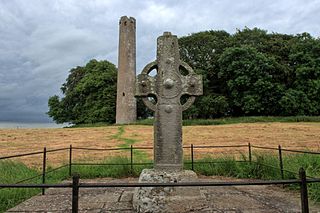
Kilree is a former Christian monastery and National Monument located in County Kilkenny, Ireland.

The Kilnaruane Pillar Stone is a carved monolith and National Monument located in County Cork, Ireland.

Roscam is a medieval ecclesiastical site and National Monument located in County Galway, Ireland.
Drumcliff Monastery was located in Cairbre Drom Cliabh, now County Sligo, five miles north of the modern town of Sligo. The site consists of the remains of a round tower and several high crosses, including one outstanding example. It is currently also the site of a Church of Ireland parish church and a graveyard. It is the burial place of the poet William Butler Yeats. Founded in the 6th century by Saint Colmcille, he is said to have declared in a later literary fragment:
Beloved to my heart also in the West— Drumcliffe at Culcinne's strand.



















